With the help of folk remedies for varicose veins, you can stop the development of this disease for many years. They should not be considered as an alternative to drug treatment, but they can help relieve edema and get rid of other negative phenomena with this disease.
The effectiveness of folk methods
Folk remedies for varicose veins help activate the body's hidden forces and make it able to fight the disease itself, but it can not be considered an effective cure for this disease. Many older generation patients first begin treatment of varicose veins with folk remedies, and then see a doctor. You can't do that! First, you should always consult a phlebologist, get recommendations from him about treatment, take blood tests to determine platelet levels. All folk remedies are designed to combat the cause of the development of varicose veins, but not the consequences, so effective in the early stages of the disease.
Nutmeg Recipe # 1
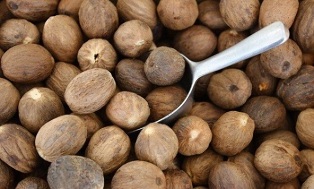
Folk remedies for varicose veins include recipes based on nutmeg. These fruits are gaining popularity due to the fact that they stimulate blood circulation. However, more than one nutmeg should not be eaten daily. This will cause intoxication and the appearance of hallucinations. Nutmeg for varicose veins is used in the following ways:
- whole beans are ground to a powder state;
- 1/3 teaspoon of the resulting product is poured with 250 ml of boiling water;
- After the mixture cools, add a tablespoon of honey.
Take this gravy before breakfast. It is best to prepare a new portion every day, otherwise the essential oils from the product will fade, which will have a negative impact on its effectiveness. Some healers recommend preparing a vodka tincture using nutmeg. 200 grams of bean powder is poured with 1 liter of vodka, the mixture is brewed for 1 week. Take the medicine 3 times a day, 20 drops 30 minutes before meals.
Recipe # 2 based on honey and propolis
Compresses for varicose veins from honey are a common way to normalize the condition of blood vessels. The cloth is smeared with honey and then rubbed on the feet. Plastic wrap wrapped over compress. If you are afraid that such a design might slip somewhere, then you can wear socks or tights on top. Compresses are recommended before bed. You can prepare tincture propolis according to the following recipe:

- 20 grams of crushed propolis and 30 grams of gray jaundice, 0, 5 lemons along with the spirit added into it;
- the resulting mixture is poured with 300 ml of vodka and insist for 3 weeks;
- infusion is ready to use for rubbing feet for a month.
Apitherapy for varicose veins is indicated for those who are not allergic to bee stings. If the patient has a mild reaction to honey or propolis, this method of treating varicose veins should not be used. The procedure is performed by a doctor. He grows a number of bees in biologically active areas. After the bite, the sting remains in the patient's body for some time, until the toxin penetrates the foot completely.
Recipe # 3 from green tomatoes
Unripe tomatoes are considered an excellent folk remedy for swelling of the legs with varicose veins. Doctors put forward the theory that uncooked vegetables contain an increase in the amount of lycopene, so compresses from this plant can relieve pain and reduce swelling of the veins. The recipe itself is quite simple. Green tomatoes are cut into large pieces and applied to venous nodes. It is recommended to secure the vegetables with a bandage. They need to keep the compress until the burning sensation appears. Healers recommend performing the procedure at night.
Ginger Recipe # 4
The benefits of this plant are legendary! It is used to improve digestion, lose weight, get rid of migraines, and so on. To treat varicose veins on the legs with folk remedies, you need raw ginger root. Normal dried spices will not work.
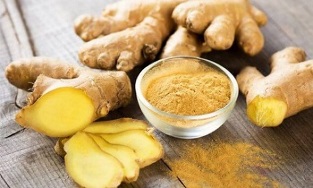
One of the popular medicines to tighten the body, increase blood flow and relieve fatigue is tea based on this spice.
Preparing tea is quite simple: you need to cut a small piece from the roots of the plant, pour boiling water over it and leave for ten to fifteen minutes. You must take this medicine at a comfortable temperature for yourself. Ginger for varicose veins helps not only overcome bad venous tone, but also activates metabolism, so that people who drink the tea gradually lose weight. Ginger compresses are also effective for varicose veins. Set up as follows:
- The roots are gently rubbed.
- The resulting gruel is mixed with honey.
- The mixture is rubbed on the inflamed veins for about three to four hours.
To enhance the compression effect, you can wrap the top with adhesive, and then wear warm pants or lie down under a blanket. The duration of treatment is one month.
Cheese Horse Recipe # 5
Treatment of varicose veins at home with folk remedies is rarely done without the use of horse chestnut. Tincture is prepared based on the fruit of the plant. The raw material is crushed with a meat grinder to a gruel state, and then put in a three-liter jar, half filling it with vodka. The mixture is injected for one month. The ratio of chestnuts to vodka must be one to three. Several times a week, while the mixture is added, it is shaken, and then returned to its place.
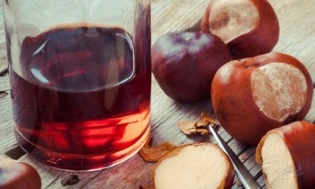
A month later, the tincture is ready to be used to wipe the varicose veins. Some healers recommend using this medicine internally, but before that you should see a doctor, as the chestnuts are poisonous and can cause bleeding, as they reduce blood clotting. You can use an infusion if there is an increased amount of platelets in your blood.
Viburnum Recipe # 6
Like ginger, fruit can be used to make fortified drinks or for compresses. Viburnum compresses for varicose veins are provided by standard. The berries are ground to a rough, then the mixture is spread on a bandage or cotton cloth, and then rubbed into the affected area. It is necessary to keep such a composition for 8-9 hours, so compresses are recommended to do before bedtime. Preparing drinks is very easy. 500 ml of juice is obtained from viburnum berries, and then 2 tablespoons of honey are added to the liquid. Allergy sufferers can do without the last ingredient. Drink 2 tablespoons 4 times a day.
Recipe # 7 based on mummy
This specialty product is great for treating swelling and congestion. If you are not afraid of unpleasant odors and high prices, then you can make compresses from mummies for varicose veins. They only help well in the early stages of the disease. Mumiyo is mixed in a ratio of 1 to 5 with petroleum jelly. Mix the ingredients until well blended. Apply the resulting ointment 3 times a day to the affected foot area. Wash 1-2 hours after application. Some recommend taking a mixture of mummy, honey and milk. It is prepared in a ratio of 1: 6: 6. Therapy lasts for 1 month.
Recipe # 8 from Adam apple
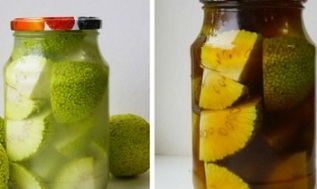
The maklu fruit is poisonous in them. You can not eat it, like snake venom, but you can use it to make homemade ointments. You will need lard (lard), Adam apples, and a glass of water. The container was filled fifteen millimeters with melted lard, and then Adam's apple slices were placed in a layer of ten mm. The procedure is repeated until all ingredients are used up. The last layer must be lard. After that, the container is placed over low heat, the resulting mixture is heated, then filtered, cooled and used as an ointment 2 times a day. In a similar way, you can cook pumpkin for varicose veins.
Recipe # 9 from lemon
Lemon treatment for varicose veins can be both external and internal. Unfortunately, regular tea with citrus will not help in improving the tone of the veins, but pure lemon juice is a good way to prevent vascular destruction. You can make lemon compress. To do this, cut the citrus into circles and apply to the affected area. You need to wear compresses all day, changing circles for new ones every 3-4 hours. Of course, for tight fitting, the legs are wrapped with a bandage.
Potato Recipe # 10
These folk remedies are the most affordable, as these root vegetables can be purchased at any vegetable store. Treatment of varicose veins in the legs in women with potatoes is done in the following way:

- Root crops are washed and peeled, and then grated on a medium grater.
- Gruel produced is spread in places damaged by the disease.
- 8 layers of bandage or gauze are wrapped over the potatoes, and then everything is fixed with adhesive.
Compresses should be stored for approximately 4 hours. It is prepared from fresh potatoes. Presenting potatoes is not suitable for this purpose.
Onion Recipe # 11
It is an effective onion peel for varicose veins, and not the vegetable itself. You can use it to strengthen your immune system, eat it raw, or cook some dishes with it. Onion skin can be prepared in one of the following ways:
- 2 tablespoons chopped onion husks pour 500 ml boiling water. The mixture is injected for 6 hours, and then filtered. Take 3 times a day, 75 ml. The course of treatment is 10 days.
- 2 tablespoons chopped onion skin poured into 100 ml of vodka. The mixture is injected for 7 days in a cool, dark place. The resulting tingtur is taken 20 drops a day 3 times a day 15 minutes before meals. The course of treatment is 14 days.
Recipe # 12 based on fish oil
Fish oil for varicose veins is most often taken orally. This product allows you to speed up metabolism and get rid of fluid stagnation in the limbs.
If, for one reason or another, you do not like taking such a drug, then you can make a compress out of it. To do this, fish oil and honey are mixed in a ratio of 1 to 1. The resulting mixture is spread on a cotton cloth or gauze, and then the limbs affected by varicose veins are wrapped. Healers recommend using May honey for compresses, but if you do not have it, you can take another type.
Celery Recipe # 13
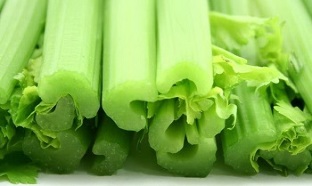
Treatment of leg veins with folk remedies is not always easy. Celery for varicose veins is contraindicated for consumption, but it can be added to carrot juice along with spinach.
Drink the resulting beverage immediately. The ratio of carrot juice to other ingredients is 7: 3: 3.
Garlic Recipe # 14
Garlic for varicose veins is effective in the form of compresses. In this recipe, the healer uses the composition of this plant directly. It contains many essential oils that naturally irritate the vascular wall. Prepare garlic compress for varicose veins as follows:
- Garlic, along with husks, is crushed to a pulp state.
- Add 1 to 2 butter to finely chopped product.
- Mix the ingredients well.
- The resulting ointment is applied to the affected vein before bed, and a bandage is wrapped around it. The duration of treatment is 1 month.
Recipe # 15 based on wormwood
Among the folk remedies for varicose veins in the legs, those who have wormwood in its composition are considered effective in the second stage of the disease. This plant promotes blood thinning, so it is effective in the second stage of the disease. The plant also stimulates digestion, increases bile flow from the liver, and increases overall metabolism. When used properly, plants contribute to the destruction of pathogenic microflora in the body. Wormwood for varicose veins can be used in different ways:
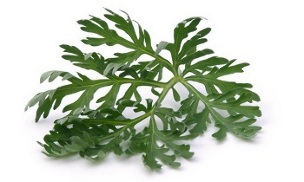
- The easiest recipe is to add 3 tablespoons of chopped herbs to a jar of 500 ml, and then fill to the top with vodka. You need to force this medicine for 14 days. Once the tincture is ready, it is used to lubricate the damaged foot area.
- Sour milk is taken from the factory to compress. It is mixed with the leaves and head of a worm. The result must be cruel. It is rubbed on the feet. Limbs wrapped. It is best to make such compresses at night.
Although wormwood is one of the effective plants against varicose veins, it should not be used for thrombophlebitis.
Rosehip Recipe # 16
Folk recipes for varicose veins often include rosehip-based decoctions. Indeed, this plant has a rich vitamin composition. It contains magnesium, phosphorus, essential oils and other beneficial substances. But by itself, rosehip with varicose veins will not force the body to grow again. Rosehip tincture must be taken in small doses, as it can provoke blood clots and arrhythmias. For this reason, it is possible to treat varicose veins with this plant only after obtaining the official approval of the doctor. Doctors recommend treating with rose hips in the following cases:
- with severe mental or physical fatigue;
- with increased cholecystitis, to facilitate bile outflow;
- if the skin peels off strongly due to vitamin deficiency;
- if you have digestive problems.

Tingtur is not difficult to complete. 15 grams of the plant is poured with 500 ml of boiling water, and then wait for the broth to cool.
Do not take this medicine on an empty stomach. It can only be eaten after a meal. It is best to drink about 100 ml of broth 3 times a day. For the flu, you can add raspberries to roses. This broth activates the body's immune system.
Nettle recipe # 17
Netting for varicose veins helps eliminate high platelet count. Treatment can be done both with the help of specialized decoctions, and with other methods. Treatment of the affected area with nettle broom is considered very effective for the treatment of varicose veins. Movement should be from foot to hip. The first few hours of the treated area will be itchy, but everything will pass. The advantage of this procedure is the activation of blood flow.
Herbal remedies for varicose veins also include taking nettle-based decoctions. 2 tablespoons of dried leaves of the plant must be crushed, and then added to a thermos, pouring 2 cups of boiling water. The product should be injected for 3-4 hours. Once the infusion is ready, it is taken at 1/3 of the total 3 times a day. When the liquid runs out, you need to cook more.
Recipe # 18 based on aloe
With the help of aloe, varicose veins can be treated only at an early stage. This plant stimulates tissue regeneration, but by itself does not need to help the disease. It is recommended to combine it with drug therapy. Aloe for varicose veins can be used in the following ways:

- Rub your feet with aloe juice. This will help relieve muscle cramps and reduce leg swelling.
- Mix 100 grams of aloe juice with 5 grams of mummy. Legs are lubricated 2 times a day for 28 days. The drug also promotes the healing of mild skin lesions, but should not be used for trophic ulcers.
- Mix Kalanchoe and aloe juice in equal parts, and then add 30 ml of vodka into it. Stir the mixture until well blended, and then use to rub into your feet.
- Mix equal parts aloe juice, sea buckthorn and olive oil, and then rub the resulting mixture on the feet 2 times a day for 1. 5 months.
Recipe # 19 based on a golden mustache
Collisions are known as universal cures for various ailments. The effectiveness of plants in the treatment of various diseases is very easy to explain. It has a rich composition. Using a golden mustache for varicose veins along with other ingredients has a stronger effect than using a single ingredient. To increase blood flow, it is recommended to use the following folk remedies for varicose veins:
- 3-4 finely chopped golden mustache leaves mixed with 2 cups of honey;
- add the juice of 6 lemons and 5 crushed garlic heads to the mixture;
- components are thoroughly mixed, covered in glass containers and stored for 7 days.
The resulting mixture is taken in 2 teaspoons 2 times a day for a month. This composition will help eliminate complications in varicose veins and reduce severe edema.
Lilac Recipe # 20

The purple texture for varicose veins is made from the leaves according to the standard scheme, that is, they fill half a jar of 500 ml with it, and then add vodka there. The mixture is injected for a week, and then the limbs are coated with the resulting medication. It is permissible to use the flowers of this plant instead of the leaves. Traditional healers recommend using purple bark to combat varicose veins. It is applied to the affected area, and from above is fitted with a bandage. You need to wear compresses all day.
Recipe # 21 based on flax seeds
Use flaxseed for varicose veins if severe swelling is observed. This product will help remove excess fluid. Folk healers recommend using flaxseed decoction every 2 hours. Set up as follows:
- Put on fire 500 ml of water and bring to a boil;
- add 4 tablespoons of flax seeds;
- The mixture is boiled for 15 minutes, then cooled and filtered if necessary.
Take the resulting broth should be 4 tablespoons every 2 hours until the swelling becomes less. Be sure to read the contraindications to its use before using the product. They are in seed packaging.
Mud Recipe # 22
Doctors are not clear about the treatment of varicose veins with mud. Some experts say that this procedure improves blood circulation, helping the body get rid of toxins, while others argue that it can be harmful.
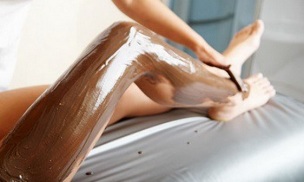
Mud treatment for varicose veins must be a cold. At home, peloid therapy is carried out by wrapping the body. You need to:
- wooden bowls and spoons (metal should not be used);
- linked movies;
- dirt (available at pharmacies or beauty stores);
- various additives.
In some cases, clay can be added to the mud. These components work well with each other. The mixture is diluted with water at room temperature until sour cream, and then applied to the affected area of varicose veins. This composition is stored on the skin for 1-2 hours. If you feel dry or tight, rinse with dirt, check your body for allergies, and use a moisturizer.
Recipe # 23 of carrots
The tops of carrots for varicose veins have been used for 30 years. The top of the crop can be obtained from any summer resident. Before preparing the tincture from this part of the vegetable, it is necessary to lubricate the leaves with boiling water. This manipulation will relieve the plant from bitter taste. Remedies for the treatment of varicose veins can be prepared according to one of the following recipes:
- For the broth, 10 tablespoons of finely chopped top is mixed with 2 liters of water. The resulting mixture is heated over low heat, filtered, and then drunk in 20 ml 3 times a day. The duration of treatment is 14 days.
- One tablespoon of raw material is poured with 500 ml of boiled water, infused for 1 hour, and then drunk in 100 ml 3 times a day.
- A more concentrated infusion is provided in a thermos. Pour 1 tablespoon of herbs with a glass of boiling water, and then leave for 30 minutes. After the infusion is cold, drink it all. Take up to 5 servings of this product a day.
Clay Recipe # 24
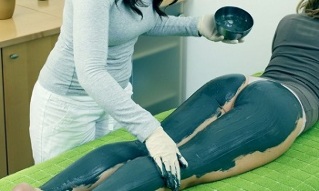
This fine sedimentary stone is used in various cosmetic procedures. It is best used for the treatment of vascular diseases, blue clay. It penetrates the skin barrier perfectly and contains many beneficial trace elements. The most popular are the following clay recipes:
- 200-300 grams of dry raw material diluted with water until consistently thick sour cream;
- the resulting mixture is placed in the area where there is swelling of the vein (layer thickness - 2 cm);
- terry towels are placed on the skin with clay;
- , if you want, you can fix the applique with cling film.
Put the resulting product on your feet for at least 2 hours. Folk healers recommend making an application every day. The duration of treatment is 1. 5 months. Once the condition of the feet improves, the thick clay mixture can be replaced with a terry towel soaked in a clay solution.
Remember, clay is not for everyone. If you have sensitive skin, replace blue clay with red or pink if dry or irritated. If acne occurs, the product must be discarded.
Recipe # 25 from hydrogen peroxide
This person's technique is considered a little dangerous to health, and especially to the pancreas, so a consultation with a doctor is required. Hydrogen peroxide from varicose veins is used in two ways. The first is to take the medication orally. 1 drop of peroxide is diluted in 3 tablespoons of water and consumed 2 hours after meals. Every day, the concentration of the substance increases by 1 drop, up to 10 drops. After that, rest for 72 hours and start taking 10 drops every 2 days. Interval of 3 days between doses.
The second method is more invasive. The patient prepared a 0, 015% hydrogen peroxide solution, and then injected it intravenously with drops. If you do not have experience in such manipulation, then it is better not to do it. This introduction of hydrogen induces the release of atomic oxygen. The walls of the vessel are cleaned, until the edema disappears. The maximum dose of a given substance at a time is 250 ml.
Duration and rules of treatment with folk remedies
One of the main factors influencing the effectiveness of alternative treatments is the stage of the disease. With a little stretching of the ducts, they will help relieve swelling, improve skin condition, and restore vein tone. Knowing what to fear for varicose veins, you can prevent its further development, but you should not stop treatment completely once the symptoms of the disease disappear. You should repeat the procedure with folk remedies that come to you every 3-4 months to prevent relapse. Treatment rules:
- Mix the ingredients according to the ratio recommended in the recipe.
- In case of burning, itching and other incomprehensible reactions, discontinue use of the product.
- Use the finished drug for the duration of the recommended treatment, and not until the first improvement.
- Store in a cool place to prevent premature deterioration.
Combination with traditional treatment methods
It is possible to incorporate traditional medicine into drug therapy only with the permission of a phlebologist. Remember that at least 2 hours should pass between the use of different tinctures and tablets. By using folk remedies, you should know clearly that such medicines cannot replace medicines, although some healers think that this is not the case. In addition, some homemade drugs can pose a risk to life, so treatment with such a method should be done very carefully.
Possible risks and contraindications
Folk medicine is not an effective medicine. They themselves can cause allergies and other negative reactions from the body. The use of traditional medicine is contraindicated for the following diseases:
- stomach and intestinal diseases;
- problems with blood clotting;
- liver and kidney disease;
- advanced level of varicose veins is accompanied by venous thrombosis.
Patients are asked to discuss any treatment with a doctor. It is not recommended to give traditional medicine to yourself without examining the body.




































